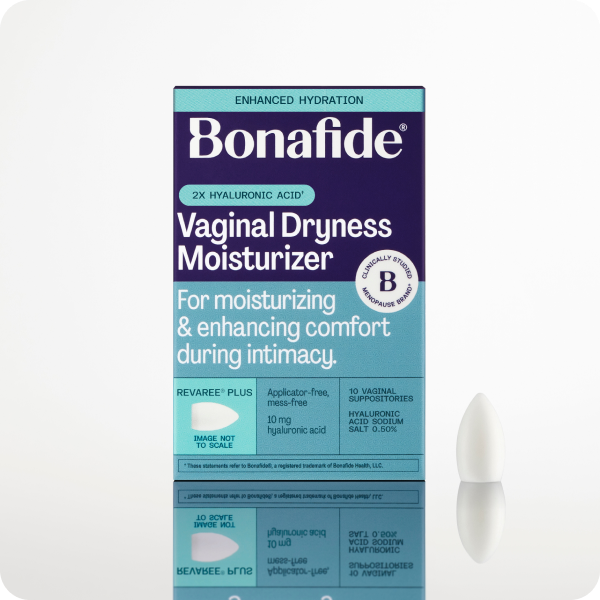Sexuality is not defined by age. However, age-related hormonal and physiological changes may contribute to a variety of sexual health difficulties and disappointments during menopause. Many women in long-term relationships often report a decline in spontaneous sexual desire, orgasm and the perception of excitement leading up to, during and after menopause. For women, sex often shifts from exciting and passionate to monotonous and obligatory due to repetitive experiences with predictable elements.
Wondering how to improve your sex drive during menopause? Sexual aids, toys, and lubricants can offer individuals and couples the opportunity to reinvigorate their sexual experiences, no matter their age.
Sex and Menopause: Common Changes to Expect
The average age of menopause in the U.S. is 51.1 As women near menopause, changes occur to their production of hormones such as estrogen and progesterone. Eventually, their ovaries stop producing estrogen and progesterone altogether, leading to the discontinuation of menstruation. Low estrogen can also contribute to a reduced sex drive, vaginal dryness, and painful sex.
In addition, the production of testosterone tends to decline throughout a woman’s lifetime, so that by the time she reaches menopause, she’s also dealing with low testosterone. While testosterone occurs at higher levels in men, this hormone plays a key role in sexual desire and response in women as well, aiding vaginal lubrication and the maintenance of healthy vulvar and vaginal tissue. Overall, all three of these hormones play an integral role in female sexual function.
Vaginal Dryness Treatment: Lubricants and Moisturizers
While vaginal dryness and sexual pain during and after menopause are not uncommon, such symptoms don’t have to be tolerated. Any woman experiencing difficulties with sex related to dryness and pain should seek evaluation by a gynecologist or sexual medicine expert.
In some cases, women experiencing vaginal dryness and/or painful sex during menopause may require prescription therapy, such as local vaginal estrogen, to help manage symptoms. For others, over the counter (OTC) vaginal moisturizers and lubricants can be quite helpful. Women should know what they are using and why, in order to potentially limit additional irritation and pain. Many OTC vaginal products contain preservatives and other harsh ingredients that can be caustic to already sensitive vulvar and vaginal tissue and may be disruptive to the normal vaginal ecosystem. Be sure to consult with your healthcare provider if you have any questions; they may have specific recommendations that can help.
It’s important to note that vaginal moisturizers and lubricants are not the same. Moisturizers provide longer term relief of vaginal dryness by absorbing into vulvar and vaginal tissues. They can be applied topically or inserted vaginally and are typically used on a more continuous basis. Lubricants are external products that provide temporary relief of vaginal dryness during sexual activity and a popular female sex enhancer. In general, moisturizers are used continuously to manage chronic symptoms, while lubricants are used as needed.
Vaginal Moisturizers
Several naturally occurring ingredients have been shown to help provide lasting moisture for dry vaginal tissues. Examples of commonly used natural moisturizers include organic coconut oil, vitamin E oil, and hyaluronic acid. While natural oils can be an effective option for some women, others may find them messy or inconvenient. Hyaluronic acid, on the other hand, is unique. A molecule found naturally in the body, hyaluronic acid works to retain moisture within tissue,2 making it an effective, longer term vaginal dryness treatment.
As mentioned, topical hormone treatments are another option for addressing vaginal dryness and painful sex. However, these require a prescription from your doctor and may come with side effects or risks. Be sure to discuss all of your options with your healthcare provider to determine what’s best for your unique needs.
Vaginal Lubricants
Common OTC lubricants are either water-, silicone-, or oil-based. Avoid products that contain glycerin, parabens, and other harsh chemicals to prevent further vaginal irritation.
Women relying upon condoms for contraception and sexually transmitted disease (STD) prevention should be aware that oil-based lubricants and moisturizers may break down the integrity of natural rubber, latex, polyisoprene or polyurethane products. Water- and silicone-based products are a better choice if you are using condoms.
Supplements: Women’s Sex Drive Enhancer Inspired by Nature
Decreased sex drive and reduced sexual arousal and orgasm are commonly experienced by menopausal women. Changes in hormones are often the culprit, which can cause decreased blood flow to the vaginal area. This decrease can negatively impact the body’s response to physical stimulation and even the ability to achieve climax.
There are a handful of products currently available that claim to support female sex drive. However, many are not supported by sufficient scientific research. There are also several naturally occurring herbs and ingredients that claim to help to increase sex drive in women, but more research is needed in order to determine their actual benefits.
Take care when considering supplements that claim to enhance the female sexual response. Since weakened blood flow to the genitals can often be the cause of decreased sexual arousal and orgasm in menopausal women, it may help to choose a supplement that works to enhance this function.
Learn more about Ristela
Best Sex Toys for Menopausal Women
Approximately 54% of women admit to using vibrators,4 yet open discussion of sexual devices remains somewhat taboo. During menopause, vibrators can serve as an effective option to intensify stimulation to erogenous zones such as the clitoris, labia, vagina, anus and breasts.
Vibrators come in various shapes, sizes, speeds, colors, and levels of intensity; chances are there’s an option to suit your specific desires. While many women prefer using vibrators externally on the clitoris and labia, some are designed for internal vaginal and anal use or for other erogenous areas, such as the nipples and lips.
Small, handheld bullet vibrators provide localized sensation to the clitoris and are discreet. There are some products available that work to provide stimulation, but also help to strengthen pelvic floor muscles and improve orgasms. This can be an added benefit for women in menopause, since pelvic muscle strength can weaken during this time. For women with decreased dexterity, larger, electric hand-held personal massagers, like The Magic Wand, can be useful.
Interested in incorporating toys into partnered sexual activity? Dame Products offers a wearable external vibrator designed to stimulate the clitoris. Flexible vibrating rings that fit on the base of the penis benefit both male and female partners. We-Vibe offers other wearable devices that also work to stimulate both partners.
Human sexuality should be enjoyed and celebrated throughout menopause and beyond. Women can and should feel empowered to explore their sexuality for as long as they desire. The inclusion of lubricants, aids, and toys may be just what’s needed to increase sexual pleasure during menopausal years.
For a quick video from Chief Medical Officer, Dr. Alyssa Dweck, check out the below clip:
Resources
- Al-Azzawi, F., & Palacios, S. (2009). Hormonal changes during menopause. Maturitas, 63(2), 135-137.
- John, H. E., & Price, R. D. (2009). Perspectives in the selection of hyaluronic acid fillers for facial wrinkles and aging skin. Patient preference and adherence, 3, 225.
- Bottari, A., Belcaro, G., Ledda, A., Cesarone, M. R., Vinciguerra, G., Di Renzo, A., ... & Hosoi, M. (2012). Lady Prelox® improves sexual function in post-menopausal women. Panminerva medica.
- J Sex Med. 2009 Jul;6(7):1857-66. doi: 10.1111/j.1743-6109.2009.01318.x. Epub 2009 May 7.Prevalence and characteristics of vibrator use by women in the United States: results from a nationally representative study. Herbenick et al, 2009.












Comments
Post commentSo much more information than my doctor gives me thank you!